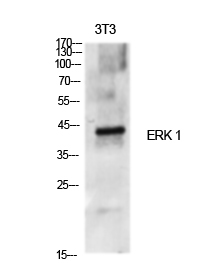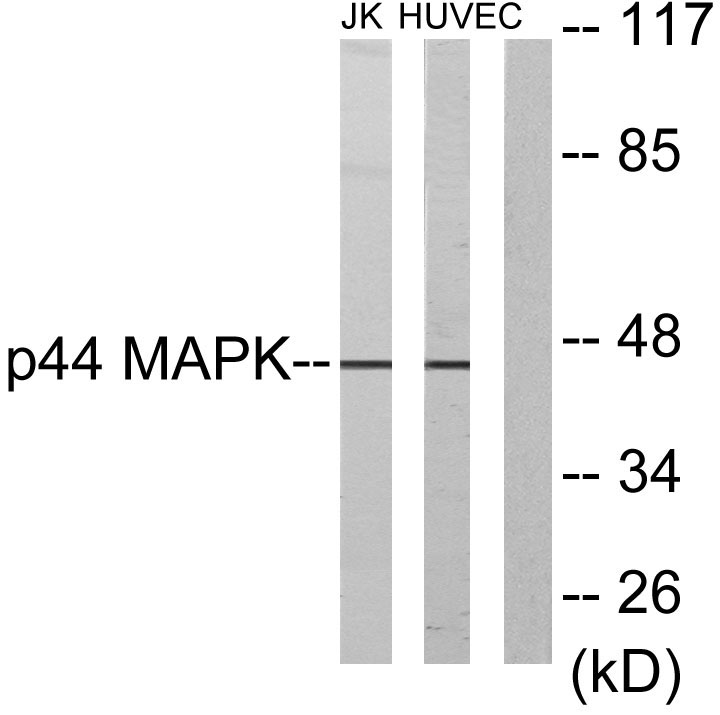ERK 1 Polyclonal Antibody
- Catalog No.:YT1622
- Applications:WB;IF;ELISA
- Reactivity:Human;Mouse;Rat
- Target:
- ERK 1
- Fields:
- >>EGFR tyrosine kinase inhibitor resistance;>>Endocrine resistance;>>Platinum drug resistance;>>MAPK signaling pathway;>>ErbB signaling pathway;>>Ras signaling pathway;>>Rap1 signaling pathway;>>cGMP-PKG signaling pathway;>>cAMP signaling pathway;>>Chemokine signaling pathway;>>HIF-1 signaling pathway;>>FoxO signaling pathway;>>Sphingolipid signaling pathway;>>Phospholipase D signaling pathway;>>Oocyte meiosis;>>Autophagy - animal;>>mTOR signaling pathway;>>PI3K-Akt signaling pathway;>>Apoptosis;>>Cellular senescence;>>Adrenergic signaling in cardiomyocytes;>>Vascular smooth muscle contraction;>>TGF-beta signaling pathway;>>Axon guidance;>>VEGF signaling pathway;>>Apelin signaling pathway;>>Osteoclast differentiation;>>Focal adhesion;>>Adherens junction;>>Gap junction;>>Signaling pathways regulating pluripotency of stem cells;>>Platelet activation;>>Neutrophil extracellular trap formation;>>Toll-like receptor signaling pathway;>>NOD-like receptor signaling pathway;>>C-type lectin recep
- Gene Name:
- MAPK3
- Protein Name:
- Mitogen-activated protein kinase 3
- Human Gene Id:
- 5595
- Human Swiss Prot No:
- P27361
- Mouse Gene Id:
- 26417
- Mouse Swiss Prot No:
- Q63844
- Rat Gene Id:
- 50689
- Rat Swiss Prot No:
- P21708
- Immunogen:
- The antiserum was produced against synthesized peptide derived from human p44 MAPK. AA range:161-210
- Specificity:
- ERK 1 Polyclonal Antibody detects endogenous levels of ERK 1 protein.
- Formulation:
- Liquid in PBS containing 50% glycerol, 0.5% BSA and 0.02% sodium azide.
- Source:
- Polyclonal, Rabbit,IgG
- Dilution:
- WB 1:500 - 1:2000. IF 1:200 - 1:1000. ELISA: 1:40000. Not yet tested in other applications.
- Purification:
- The antibody was affinity-purified from rabbit antiserum by affinity-chromatography using epitope-specific immunogen.
- Concentration:
- 1 mg/ml
- Storage Stability:
- -15°C to -25°C/1 year(Do not lower than -25°C)
- Other Name:
- MAPK3;ERK1;PRKM3;Mitogen-activated protein kinase 3;MAP kinase 3;MAPK 3;ERT2;Extracellular signal-regulated kinase 1;ERK-1;Insulin-stimulated MAP2 kinase;MAP kinase isoform p44;p44-MAPK;Microtubule-associated protein 2 kinase;p
- Observed Band(KD):
- 45kD
- Background:
- The protein encoded by this gene is a member of the MAP kinase family. MAP kinases, also known as extracellular signal-regulated kinases (ERKs), act in a signaling cascade that regulates various cellular processes such as proliferation, differentiation, and cell cycle progression in response to a variety of extracellular signals. This kinase is activated by upstream kinases, resulting in its translocation to the nucleus where it phosphorylates nuclear targets. Alternatively spliced transcript variants encoding different protein isoforms have been described. [provided by RefSeq, Jul 2008],
- Function:
- catalytic activity:ATP + a protein = ADP + a phosphoprotein.,cofactor:Magnesium.,domain:The TXY motif contains the threonine and tyrosine residues whose phosphorylation activates the MAP kinases.,enzyme regulation:Activated by tyrosine phosphorylation in response to insulin and NGF.,function:Involved in both the initiation and regulation of meiosis, mitosis, and postmitotic functions in differentiated cells by phosphorylating a number of transcription factors such as ELK-1. Phosphorylates EIF4EBP1; required for initiation of translation. Phosphorylates microtubule-associated protein 2 (MAP2). Phosphorylates SPZ1 (By similarity). Phosphorylates heat shock factor protein 4 (HSF4).,PTM:Dually phosphorylated on Thr-202 and Tyr-204, which activates the enzyme.,similarity:Belongs to the protein kinase superfamily.,similarity:Belongs to the protein kinase superfamily. CMGC Ser/Thr protein kinas
- Subcellular Location:
- Cytoplasm . Nucleus. Membrane, caveola . Cell junction, focal adhesion . Autophosphorylation at Thr-207 promotes nuclear localization (PubMed:19060905). PEA15-binding redirects the biological outcome of MAPK3 kinase-signaling by sequestering MAPK3 into the cytoplasm (By similarity). .
- Expression:
- Epithelium,Eye,Hepatoma,Human cervix,Lymph,
CD38 affects the biological behavior and energy metabolism of nasopharyngeal carcinoma cells. INTERNATIONAL JOURNAL OF ONCOLOGY Int J Oncol. 2019 Feb;54(2):585-599 WB Human 1:500 5-8F cell
- June 19-2018
- WESTERN IMMUNOBLOTTING PROTOCOL
- June 19-2018
- IMMUNOHISTOCHEMISTRY-PARAFFIN PROTOCOL
- June 19-2018
- IMMUNOFLUORESCENCE PROTOCOL
- September 08-2020
- FLOW-CYTOMEYRT-PROTOCOL
- May 20-2022
- Cell-Based ELISA│解您多样本WB检测之困扰
- July 13-2018
- CELL-BASED-ELISA-PROTOCOL-FOR-ACETYL-PROTEIN
- July 13-2018
- CELL-BASED-ELISA-PROTOCOL-FOR-PHOSPHO-PROTEIN
- July 13-2018
- Antibody-FAQs
- Products Images

- Western Blot analysis of various cells using ERK 1 Polyclonal Antibody diluted at 1:500
.jpg)
- Western Blot analysis of 3T3 cells using ERK 1 Polyclonal Antibody diluted at 1:500

- Western blot analysis of lysates from Jurkat and HUVEC cells, using p44 MAPK Antibody. The lane on the right is blocked with the synthesized peptide.



